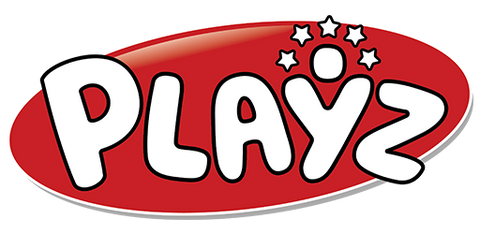
Discover The Play Based Learning Benefits for Kids
Play-based learning isn't just fun and games; it's a powerful educational approach that lets kids explore, create, and solve problems in a way that feels completely natural. Unlike traditional rote memorization, this method builds critical thinking, social skills, and emotional resilience, setting children up for a lifetime of confident learning.
The Hidden Genius in Your Child's Playtime
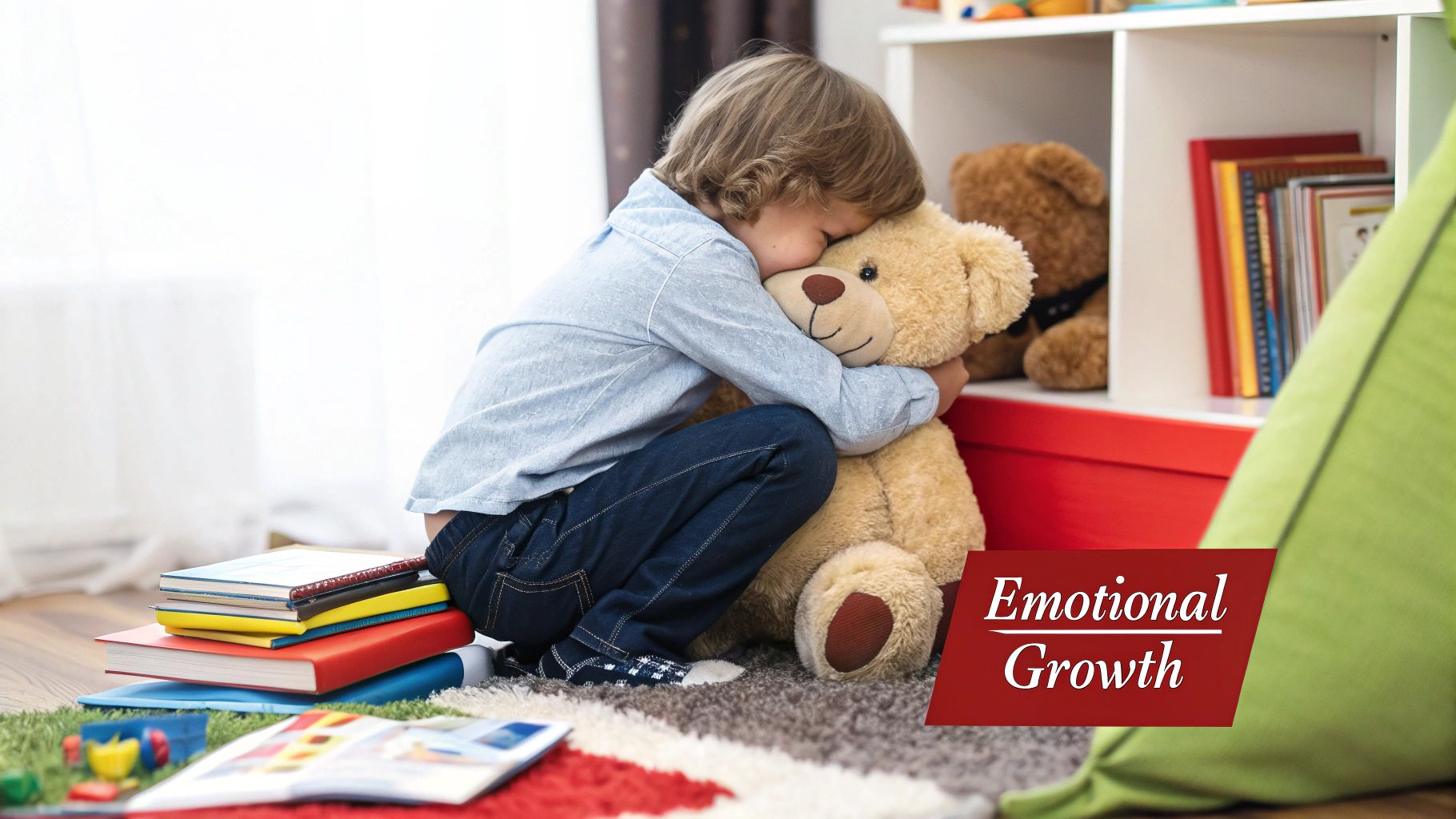
Ever watched a child get laser-focused on building a block tower? To an adult, it’s a simple game. For the child, it's a hands-on physics experiment in balance, gravity, and structural integrity. They are testing hypotheses in real-time with every block they place.
That make-believe tea party isn't just cute, either. It’s a masterclass in negotiation, turn-taking, and social etiquette. Every imaginative scenario is an opportunity to practice complex life skills, cleverly disguised as fun.
This is the core principle of play-based learning. It challenges the outdated notion that "real" learning only happens with worksheets and flashcards. Instead, it recognizes that play is the most effective and natural engine for a child's development.
Unpacking the Power of Play
This approach isn’t about unstructured chaos. It's about designing an environment where learning is guided by a child's innate curiosity, making it deeply personal and engaging. It’s a blend of their natural drive to explore with just enough purposeful guidance to foster holistic growth. The benefits extend far beyond academics, touching every aspect of a child's development.
Key Takeaways:
- Cognitive Growth: Play sharpens problem-solving skills, critical thinking, and creativity. For example, figuring out how to make a sandcastle stand up requires trial and error.
- Social Development: Collaborative games teach communication, cooperation, and empathy. Negotiating the rules of a game is a real-world lesson in social skills.
- Emotional Regulation: Play provides a safe space for children to learn how to manage big feelings, like the frustration of a block tower falling over.
- Physical Skills: Activities like running, jumping, and building with small objects enhance both gross and fine motor skills.
Play is often talked about as if it were a relief from serious learning. But for children play is serious learning. Play is really the work of childhood. - Fred Rogers
This philosophy is about building foundational skills that serve a child for life. For a deeper look at a similar hands-on method, our guide on what discovery-based learning is explains how it sparks natural exploration.
Why Play-Based Learning Matters for Future Success
Research consistently shows significant long-term advantages. A 2015 longitudinal study in Wales, for instance, found that children in a play-based curriculum up to age seven demonstrated better academic outcomes and higher well-being scores later on.
This is because play isn't frivolous; it’s how children build essential life skills like teamwork, creative problem-solving, and self-regulation. The confidence and curiosity sparked by play-based learning create a resilient, engaged learner for life.
What Does Play Based Learning Actually Look Like?
When people hear "play-based learning," they often picture chaos—kids running wild without any rules. That couldn't be further from the truth. Effective play-based learning is a thoughtful, intentional approach that balances child-led exploration with gentle adult guidance. The magic happens when these two styles work together.
Imagine a child in a sandbox. When left to their own devices—digging, pouring, and building—that's unstructured free play. They are the director of their own show, driven entirely by curiosity. This type of play is vital for building independence and imagination.
Now, picture an adult joining in. Not to take over, but to add a new layer. They might bring over measuring cups and ask, "I wonder how many cups of sand it will take to fill this bucket?" This is guided play. The child is still in control, but the adult has introduced tools and questions that subtly guide them toward exploring concepts like volume and measurement.
The Spectrum of Playful Learning
Both unstructured and guided play are essential pillars of a strong learning environment. While unstructured play builds creativity and self-reliance, guided play helps connect those explorations to specific learning goals. This infographic breaks down some of the key benefits that come from this balanced approach.
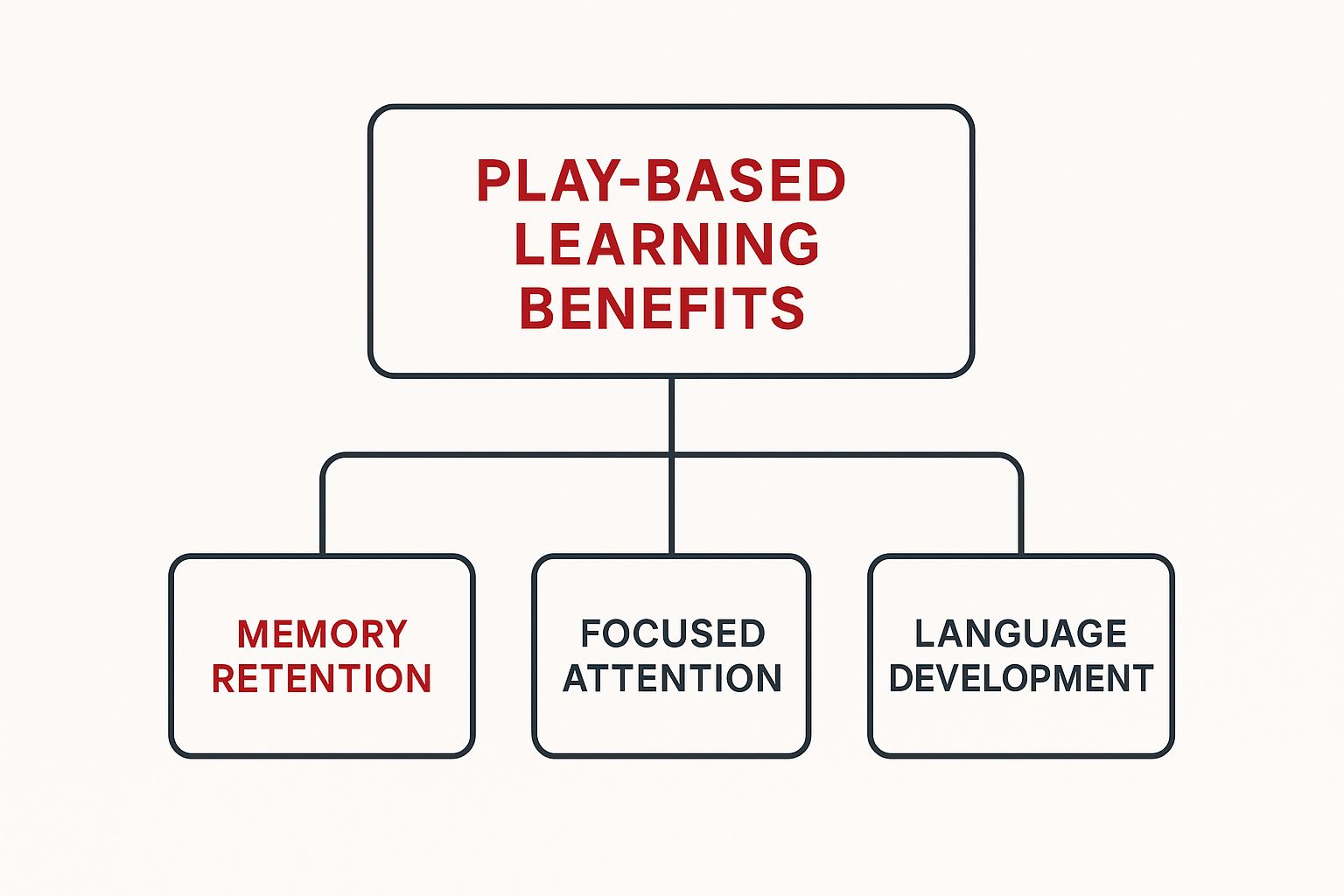
As you can see, core cognitive skills like memory, attention, and language get a direct boost when children are engaged in meaningful play. The most effective learning environments strike a beautiful balance, allowing a child's natural instincts to lead while adults provide resources and prompts to deepen the learning.
"Play is the highest form of research." - Albert Einstein
Einstein's quote perfectly captures the essence of this approach. Children aren't just messing around; they are actively researching their world, testing theories, and building knowledge in the most natural way possible.
To better understand these approaches, let's compare them side-by-side.
Comparing Play Based Learning Approaches
| Feature | Unstructured Free Play (Child-Led) | Structured Guided Play (Adult-Facilitated) |
|---|---|---|
| Leadership | 100% child-led and self-directed. The child decides what, how, and when to play. | Child-led within an environment prepared by an adult. The adult acts as a co-explorer. |
| Adult's Role | Observer; ensures safety but does not intervene in the play itself. | Facilitator; asks open-ended questions and introduces new materials to extend learning. |
| Primary Goal | Fostering creativity, independence, social negotiation, and intrinsic motivation. | Connecting play to specific learning objectives (e.g., literacy, numeracy) in a natural way. |
| Example | Kids create their own imaginative game using loose parts like boxes, sticks, and fabric. | An adult adds play money and a notepad to a "store" game to introduce concepts of commerce and writing. |
While different, both are crucial. Unstructured play gives kids the freedom to innovate, while guided play helps them make connections they might have missed on their own.
Finding the Right Balance in Practice
So, how do you achieve this balance in the real world? It starts with creating an environment rich with possibilities. A great play space is filled with open-ended materials—like blocks, art supplies, and natural items—that can be used in countless ways.
An adult's role is to observe and be ready to step in with a thoughtful question or a new material at just the right moment.
Actionable Insights:
- For a child frustrated with a falling block tower: Instead of fixing it, ask, "What do you notice about the wide blocks versus the skinny ones?" This prompts critical thinking.
- For a group playing "restaurant": Bring over a notepad and pencils to encourage taking "orders," which seamlessly integrates early writing skills.
These small interventions don't interrupt the play; they enrich it by building bridges between a child's imaginative world and foundational academic skills. For more ideas, explore our list of engaging hands-on learning activities you can set up at home.
How Play Builds a Stronger, Smarter Brain
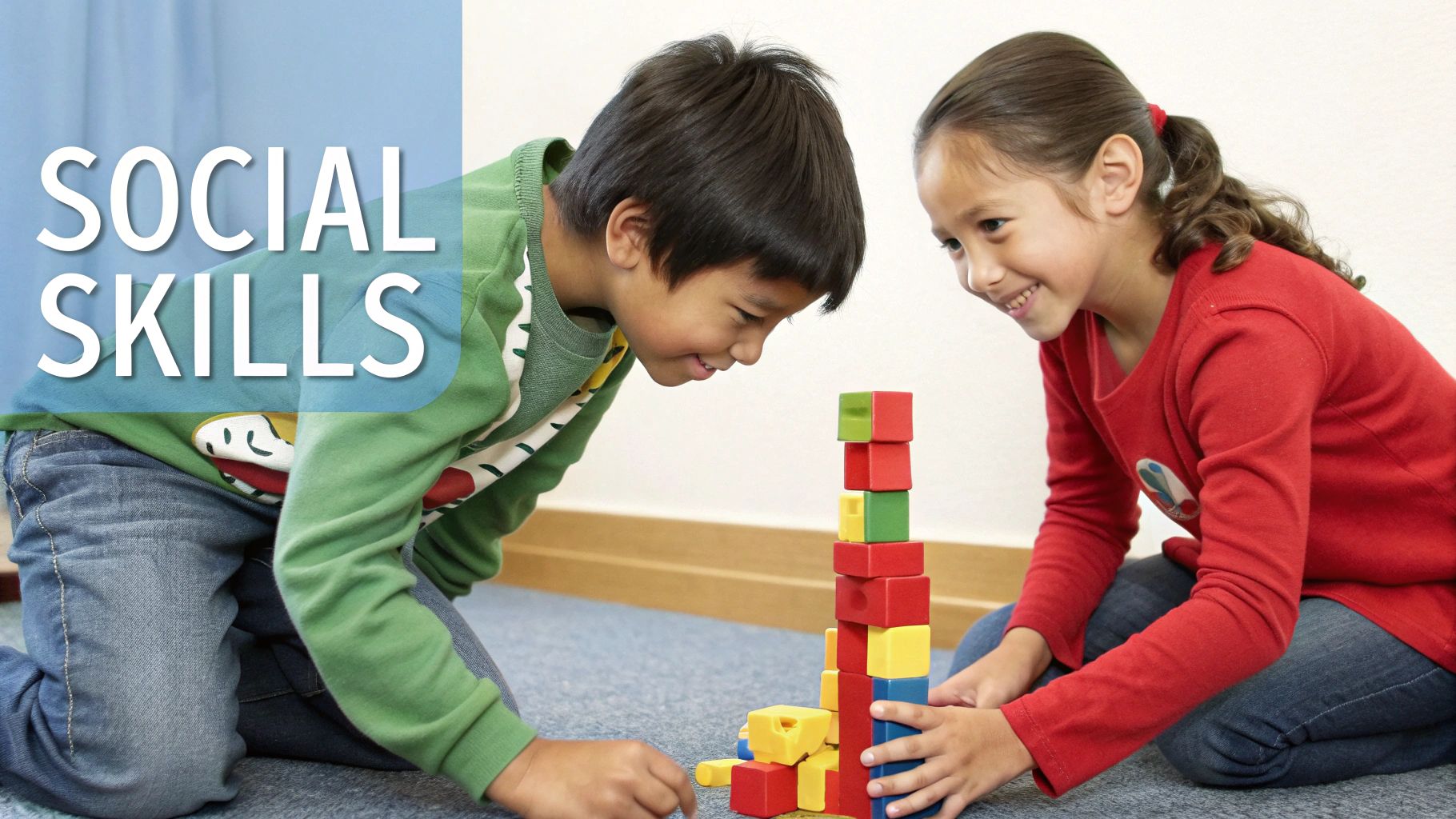
Behind every giggle and "aha!" moment during playtime, a child's brain is undergoing a remarkable transformation. Play is the engine of cognitive growth, physically wiring their brain for future learning. This process is driven by neuroplasticity—the brain's ability to form new connections based on experiences.
Think of a child's brain as a new city under construction. Every time they play, they lay down new neural pathways. Stacking LEGOs isn't just building a tower; it’s a full workout for spatial reasoning, fine motor skills, and engineering concepts. This hands-on exploration strengthens the pathways for logic and creativity, creating a solid foundation for later learning.
From Pretend Play to Problem-Solving
Pretend play is one of the most powerful brain-builders. When children create imaginary worlds—becoming brave knights or caring doctors—they are developing their capacity for abstract thought.
Real-World Example:
Imagine a child turning a cardboard box into a spaceship. This single act involves:
- Symbolic Thinking: Understanding that one object can represent another is the foundation for comprehending letters and numbers.
- Vocabulary Expansion: They invent dialogue and describe new settings, experimenting with language in a meaningful context.
- Sequential Planning: They must decide the "plot" of their adventure—what happens first, next, and last—which exercises executive functioning skills.
These scenarios are essentially complex problem-solving drills disguised as fun. Children learn to adapt when a friend adds a plot twist or resolve conflicts to keep the game going. This builds a resilient, flexible mind. To dive deeper, check out our guide on how to develop problem-solving skills in children.
"Play is the work of the child." - Maria Montessori
This famous insight perfectly captures how children learn best. Their play is serious business, driving cognitive development and giving them the mental tools to understand the world.
The Measurable Impact of Playful Learning
The benefits of play-based learning are backed by hard data. This approach leads to measurable gains in academic areas because it makes learning relevant and exciting.
A major review by the Education Endowment Foundation found that play-based approaches deliver significant positive results. The review showed that children in these programs gained approximately four additional months of learning progress in areas like early literacy and math compared to those in more traditional settings. This data confirms that when learning is joyful, it sticks.
Growing Hearts and Minds: Social and Emotional Skills in Play
Play doesn't just build smarter brains—it builds kinder hearts. The playground and the living room floor are the first laboratories where children learn the complex art of being human. It’s in the middle of the fun that they build the social and emotional skills that will shape their relationships for life.
When a group of kids tries to agree on the rules for a game, they are getting a high-stakes lesson in communication and compromise. When one child’s block tower crashes and another offers a hug or helps rebuild, that’s empathy in action. These moments are the bedrock of emotional intelligence.
Learning to Handle Big Feelings
Play is the perfect safe space for kids to explore and manage overwhelming emotions. When a child waits for a turn on the slide, they are practicing patience and self-control. Sharing a favorite toy is a powerful lesson in seeing things from another's perspective.
These are the moments where children build their emotional toolkit. Research consistently supports this; one study of four and five-year-olds found a direct link between more playtime and better self-regulation, a critical skill for school readiness. You can explore the details of play and self-regulation on PMC.
Practical Examples of Emotional Growth Through Play:
- Role-Playing: Pretending to be a doctor caring for a sick teddy bear lets kids practice empathy and nurturing behaviors.
- Turn-Taking Games: Simple board games teach patience, fairness, and the ability to handle disappointment gracefully.
- Collaborative Building: Working on a large sandcastle or LEGO city requires cooperation, communication, and conflict resolution.
Sensory play is another amazing tool. Squishing play-doh can be incredibly calming for an anxious child or provide a safe outlet for big feelings. Exploring different sensory activities for kids is a great way to support their emotional development.
The Surprising Power of Playing Alone
While group play is vital, solo play has its own unique benefits. When a child is absorbed in building a puzzle or creating a drawing by themselves, they are developing skills that will last a lifetime.
“The creation of something new is not accomplished by the intellect but by the play instinct.” - Carl Jung
This independent play builds resilience. When a child works through a challenge on their own—like a puzzle piece that won't fit—they develop a powerful sense of "I can do this!" It’s a huge confidence booster that teaches them they are capable of solving problems without adult intervention. Solo play also nurtures self-reliance and the ability to be comfortable with one's own thoughts.
Bringing Play Based Learning into Your World
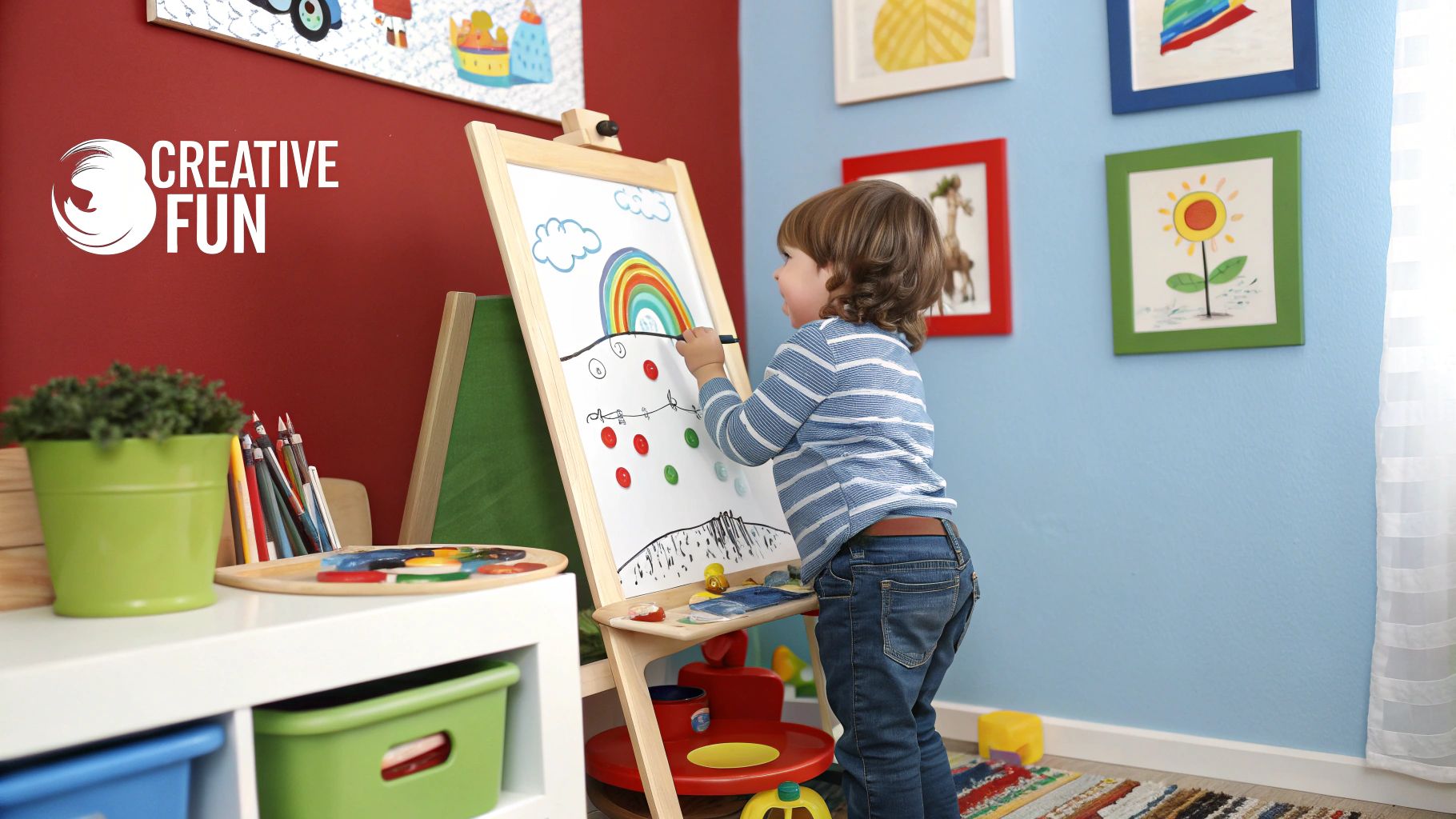
Understanding the benefits of play-based learning is one thing; bringing that magic into your home or classroom is another. The good news is that you don’t need expensive toys or complicated lesson plans. It’s all about creating an environment that sparks curiosity and invites exploration.
For parents, this can start with everyday items. A few mismatched containers in the bathtub become a lesson in volume. A pile of laundry is an opportunity to sort by color and size. The trick is to see your home through a child’s eyes—as a playground of possibilities.
Practical Tips for Parents at Home
Creating a play-rich home is more about shifting your mindset than buying more things. You can start today with what you already have.
A powerful strategy is to create an “invitation to play.” This simply means arranging a few interesting items to pique their curiosity. For example, set out some playdough, a handful of beads, and a few twigs on a tray. No instructions, no rules. Just let them explore.
Actionable Insights:
- Turn Chores into Games: Challenge them to a shape-sorting mission when putting away toys. It transforms a boring task into a learning puzzle.
- Build a Fort: Grab blankets and pillows to construct a hideaway. This is a great lesson in basic engineering, collaboration, and spatial awareness.
- Kitchen Assistants: Let them help with simple cooking tasks like stirring batter or washing vegetables. It’s a hands-on way to learn about measurement and following directions.
The most effective way to foster learning is not to push a child toward a specific goal but to create an environment so rich with possibilities that learning becomes an irresistible side effect of joyful exploration.
Asking open-ended questions is another game-changer. Instead of, “Is that a blue car?” try, “Wow, tell me about the adventure your car is going on!” This encourages storytelling and deeper thinking. For more ideas, check our guide on how to reduce screen time.
Strategies for Educators in the Classroom
For educators, the classroom is the ultimate laboratory for play-based learning. Your role is that of an architect, designing a space that encourages both independent discovery and collaboration. This often means moving away from desks and toward dynamic learning centers.
Weave your curriculum goals directly into these play areas. A dramatic play corner can become a hub for literacy as kids create signs for their pretend store or write menus for their restaurant.
Effective Classroom Strategies:
- Design Curiosity-Driven Centers: Set up distinct areas for building, art, sensory exploration, and dramatic play. Rotate materials regularly to keep them fresh.
- Observe and Document: Your most powerful tool is observation. Take notes and photos to track progress and identify learning moments you can build on.
- Integrate Learning Naturally: A block center isn’t just for stacking. Add rulers, graph paper, and pictures of famous buildings to seamlessly introduce concepts of measurement and geometry.
The goal is to be a facilitator, not a director. By providing the right materials and asking thoughtful questions, you can guide children toward deeper understanding without interrupting the magic of their play.
Why Play Sets Kids Up for Life
The skills learned during play aren't just for the playground; they are deep, meaningful, and last a lifetime. Play masterfully builds a child’s mind and heart in ways that worksheets simply can't. This isn't just about making kids happy now—it’s about building the foundation for capable, creative, and resilient adults.
From the Sandbox to the Boardroom
Think about the skills most valued in the modern workplace: collaboration, creative problem-solving, and clear communication. Children first practice these skills in the sandbox while negotiating who gets the shovel or during a game of make-believe. The grit a child develops when their block tower crashes is the same grit they'll need when a project at work goes sideways.
"Play is the royal road to childhood happiness and adult brilliance." - Joseph Chilton Pearce
This quote nails it. The imaginative, messy, and joyful work of childhood is direct training for the real world.
A Call to Champion Play
In a world obsessed with early academics, it’s more important than ever to advocate for play. It’s not an "extra" to be squeezed in after the "real" learning is done. Play is the real learning.
We must be champions for play, recognizing it as the most powerful way to prepare children for an unpredictable future. For parents, this means protecting unstructured time. For educators, it means trusting that a noisy, busy classroom is a learning classroom. For all of us, it means recognizing play for what it is: essential. When we put play first, we are empowering children to become the curious, confident, and capable people the world needs.
Frequently Asked Questions
It's natural to have questions about play-based learning. As parents and educators, we want to ensure we're setting our kids up for success. This section tackles the most common questions with clear, practical answers.
How do I know my child is actually learning?
This is the number one question parents ask. Learning in a play-based environment looks different from the worksheets many of us grew up with, but it is incredibly deep. Instead of looking for a perfect worksheet, you'll see learning in action. You'll notice it when their vocabulary expands during a game of "restaurant," when they figure out how to build a taller, more stable block tower, or when they learn to share a toy with a friend. Teachers track this progress through observation and portfolios, documenting a child's evolving problem-solving skills and storytelling abilities. These are the real signs of growth.
The real proof of learning isn't a score on a test. It's a child who isn't afraid to tackle a new puzzle, asks thoughtful questions, and keeps trying when things get a little tricky.
Will my child be ready for a traditional school?
Absolutely. A solid play-based foundation often prepares children for formal schooling better than academic-heavy preschools. The goal of early education isn't just to drill letters and numbers but to build a genuine love of learning.
Key Advantages for School Readiness:
- Strong Social-Emotional Skills: They have extensive practice taking turns, solving conflicts, and communicating their needs.
- Natural Curiosity: They view learning as a fun adventure, not a chore, making them eager students.
- Self-Regulation: They have learned to manage their impulses and focus on self-directed tasks.
These skills are the bedrock of academic success. They arrive at school ready to learn, confident, and equipped with the problem-solving abilities to thrive.
Isn’t it just unstructured chaos?
While it may look like joyful chaos, a well-run play-based classroom is anything but. It is child-led but teacher-supported. The environment is carefully crafted with intentional learning centers, where every material—from the water table to the art easel—is chosen to spark exploration of concepts like math, literacy, and science. The teacher acts as a skilled guide, asking probing questions ("What do you think will happen if we add more water to the sand?") and gently steering children toward new discoveries. It's an orchestrated dance between freedom and thoughtful guidance.
Here at Playz, we believe in the power of play. Our science kits, creative toys, and play tents are designed to ignite natural curiosity and turn playtime into a journey of discovery. Explore our collection and give your child the tools to build, create, and learn in the most joyful way possible at www.playzusa.com.
